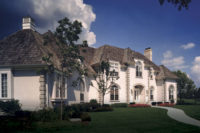
“Glass Mat” products have proven over the years to be a superior exterior sheathing product. Building on that success and responding to the demands from the architectural community to provide an interior gypsum product that is impervious to the effects of moisture, mold and mildew, glass mat products have now been developed for interior use. Although these products perform very well when subjected to limited amounts of moisture, they present certain challenges when it comes to finishing.
One of the challenges seems to be in achieving a smooth transition from areas that have received joint compound to that of the glass mat facing material. On standard paper-faced drywall products, sanding the joint compound to create a smooth transition is relatively straightforward; in fact, most manufacturers caution against over-sanding. This appears to be just the opposite when it comes to glass mat products. Even though the manufacturer’s literature states that the glass mat products can be finished similar to paper-faced drywall, they stress the fact that these products must be “adequately sanded” to produce a smooth transition.

Photo courtesy of Cer tainTeed Gypsum
Smooth Transitions
Due to the extraordinarily sturdy nature of the fiberglass mat, coupled with its rough texture, it is difficult to achieve that smooth transition. This fact becomes most apparent when the specifications have called for a Level 4 finish. Even under non-critical lighting conditions and when using flat- or low-sheen paints, the transition between compound and facing material is more discernable than on paper faced products.This leads to the question of whether or not a Level 4 finish is appropriate or should glass mat products be specified to receive a Level 5 finish only? The Northwest Wall and Ceiling Bureau believes that a satisfactory finish can only be achieved by application of a Level 5 finish. This raises a question on which method is most appropriate for achieving an acceptable Level 5 finish.
In general, the manufacturer’s literature states that these products should be “finished in accordance with the most current version of GA-214,” which recommends either a skim coat of joint compound or proprietary products specifically designed to achieve a Level 5 finish. Although the proprietary products perform very well on paper-faced wallboard, they were not specifically designed for use on non-paper faced materials. Under critical lighting conditions and with high sheen or dark colored paints, the areas that have received joint compound have a tendency to flash or telegraph as if only a Level 4 finish had been applied.

Photo courtesy of CertainTeed Gypsum
Regardless of the specified level of finish or whether the drywall is a glass mat or paper-faced drywall product, the NWCB recommends constructing a mock-up in a sample space room, demonstrating the specified surface appearance (level of finish and paint decoration) subjected to occupied lighting conditions.
The punch list process can often times become contentious. Having an approved mock-up for comparison to the actual finished product will showcase the materials in their native environment.




